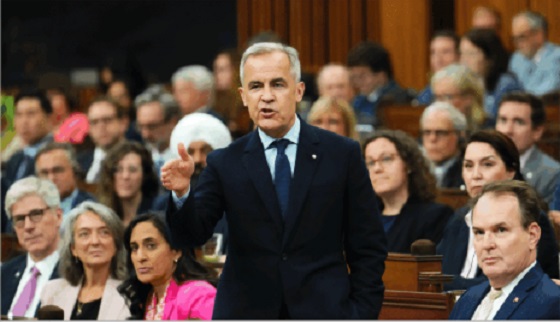Frontier Centre for Public Policy
How the new National Chief can restore the legitimacy of the AFN

Newly elected national chief of the Assembly of First Nations (AFN), Cindy Woodhouse
From the Frontier Centre for Public Policy
At times, we lose sight of the fact that not discovering bodies would be a profoundly positive outcome for First Nations and for Canada. This could help reconciliation efforts and bring peace to First Nation communities, particularly for Indigenous individuals of Christian faith.
Cindy Woodhouse, the newly elected national chief of the Assembly of First Nations (AFN), has a lot of work to do as she sets out to unify the fractured organization and rebuild its legitimacy in the eyes of First Nations across Canada.
To begin, the new national chief should forge her own independent path. Instead of immediately prioritizing internal reforms, she could facilitate reconciliation within First Nation communities by showing leadership in addressing ongoing, challenging conversations that remain unresolved in First Nation communities right now.
Although engaging in these discussions will subject her to criticism, leading from the top on difficult topics will often do that.
The first topic of conversation is the matter of unmarked graves near residential schools.
In 2021, the Tk’emlups te Secwepemc Indigenous community in British Columbia made headlines by announcing the discovery of 215 unmarked graves, believed to belong to children, through ground-penetrating radar. The allegation sent shockwaves across Canada and around the world. Mainstream media extensively covered these allegations, creating impressions of mass murder of children and human rights atrocities.
In reaction to these allegations, churches, especially Roman Catholic ones, became targets of vandalism and arson. Some individuals on reserves expressed their anger by targeting churches within their communities. Records indicate that there were over 60 incidents involving churches in 2021 alone.
Regrettably, churches affiliated with First Nation communities are still reporting attacks on their properties. At last count, some alternative media outlets are reporting a total of 100 incidents of arson and vandalism on churches. Just recently, video footage revealed an attempted arson on a Roman Catholic church in Regina, which only conservative outlets seemed to cover.
The CBC – three years late to the issue – ran an investigative story on the incidents that only seemed to serve as a platform for anti-Christian bigotry and to provide justification for the indefensible actions.
At the time, National Chief Perry Bellegarde – to his credit – condemned these acts and called for an end to them. Other prominent Indigenous voices also spoke up.
However, it’s crucial to admit that these claims of unmarked graves remain unverified and lack concrete evidence. Without excavation or exhumed bodies, it’s impossible to conclusively determine whether these are indeed human remains.
Indigenous communities in Canada must openly express this sentiment, and the national chief of the AFN is a prominent voice to convey this message.
No one denies that children died at these institutions. Tuberculosis took the lives of thousands of indigenous children who attended residential schools, day schools, or no school at all. It was a major killer of Indigenous people at the time.
However, this issue is an open and festering wound, particularly for many Indigenous communities. It is also a stain on Canadians and our collective history. Even today, Christian places of worship within Indigenous communities are subjected to reprehensible attacks.
Woodhouse must lead the AFN in addressing this difficult discussion by stating the truth. There is no evidence to substantiate the allegations of widespread child murder, and it’s time for Indigenous communities to acknowledge this and focus on healing their communities.
Conservative Leader Pierre Poilievre has stated that Parliament should launch a comprehensive investigation into the allegations of unmarked graves at the Kamloops Indian Residential School. Woodhouse should support his initiative and ensure the co-operation of all political parties. This would provide closure to many Indigenous families.
At times, we lose sight of the fact that not discovering bodies would be a profoundly positive outcome for First Nations and for Canada. This could help reconciliation efforts and bring peace to First Nation communities, particularly for Indigenous individuals of Christian faith.
No First Nation leader should want this festering wound to remain exposed.
Thankfully, the next conversation Woodhouse must address is not as difficult as the first.
As the debate rages over the carbon tax across Canada, it’s often overlooked that these taxes deeply impact First Nations. The federal government’s centralized energy policies are harming Indigenous communities. Imposing ‘clean energy’ mandates on many First Nations people who rely heavily on diesel and lack alternative options is simply not feasible for many communities. Woodhouse has said she will support a review of the impacts of the carbon tax on First Nations, but she must do more and vehemently oppose the government’s whole green agenda.
She must lead the AFN in rejecting all unnecessary and arbitrary Net Zero and clean energy targets. The government’s ‘Just Transition’ strategy – leaving resources untapped – is a direct threat to energy-producing First Nations. First Nations should have the opportunity to thrive in the energy sector just like any other community.
Both these conversations will be divisive and polarizing, but the AFN must lead them because the lack of resolution is harming Indigenous communities.
Joseph Quesnel, is a Senior Research Fellow with the Frontier Centre for Public Policy.
Frontier Centre for Public Policy
Canada’s New Border Bill Spies On You, Not The Bad Guys

From the Frontier Centre for Public Policy
By Lee Harding
Lee Harding warns that the federal government’s so-called border bill lets officials snoop on your data, ban big cash payments and even open your mail – all without a warrant
Think Bill C-2 is about stopping fentanyl? Think again. It lets the feds snoop your data, open your mail and ban big cash payments – no warrant needed
The federal government is using the pretext of border security, the fentanyl crisis and transnational crime to push through Bill C-2, legislation that dangerously expands surveillance powers, undermines Canadians’ privacy and restricts financial freedom. This so-called Strong Borders Act is less about protecting borders and more about policing citizens.
Bill C-2, a 130-page omnibus bill introduced on June 3, grants broad new powers to government agencies to spy on Canadians and share personal information with foreign countries. A more honest title might be the Snoop and Gossip Act.
Among its most intrusive provisions, the bill would make it illegal for any business, profession or charity to accept cash payments over $10,000, even if made in smaller, related transactions. Want to pay a contractor $10,001 in five separate payments for home renovations? Too bad.
The Justice Centre for Constitutional Freedoms quickly condemned the move. “Restricting the use of cash is a dangerous step toward tyranny and totalitarianism,” the organization posted to X. “Cash gives citizens privacy, autonomy, and freedom from surveillance by government and by banks.”
Under Bill C-2, internet service providers could be compelled—under threat of fines—to hand over names, locations and “pseudonyms” of users without a warrant. Any peace officer or public officer can demand this data by merely claiming “reasonable grounds to suspect” an offence “has been or will be committed.”
It doesn’t stop there. The bill would also authorize the government to open private mail under the same vague threshold of suspicion.
Experts in law and privacy say the bill is a massive overreach. University of Ottawa internet law scholar Michael Geist and Kate Robertson of the University of Toronto’s Citizen Lab both point out that successive federal governments have sought to expand internet surveillance for years, but Bill C-2 goes further than ever before.
“Bill C-2’s big brother tactics combine expansive warrantless disclosure with unprecedented secrecy,” Geist warns. He adds that the bill “overreaches by including measures on internet subscriber data that have nothing to do with border safety or security but raise privacy and civil liberties concerns.”
If the intent were truly to combat fentanyl trafficking and transnational crime, better tools already exist. Conservative MP Frank Caputo pointed out that the bill has 16 parts but says nothing about increasing penalties or jail time for fentanyl traffickers.
“There is nothing about bail in the bill,” Caputo said during early debate on the bill. “In this omnibus bill, it says that offenders can serve their sentence for trafficking in fentanyl from their couch.”
Bloc Québécois MP Claude DeBellefeuille argued that strengthening border security requires more boots on the ground. Two rural border crossings in her riding recently had their staffed hours cut in half.
“It is estimated that the CBSA (Canada Border Services Agency) already has a shortage of between 2,000 and 3,000 border services officers for current duties. If they are given new responsibilities, however necessary, there will be an even greater shortage,” she said.
Not only does Bill C-2 contradict Supreme Court precedent. It also sets the stage for Canada to share sensitive personal information with foreign governments. In 2014, the court ruled that Canadians have a “reasonable expectation of privacy in the subscriber information” provided to internet service providers and that police requests for such data amount to a “search” requiring a warrant.
Robertson warns that the bill not only defies this precedent but also enables Canada to share this dubiously acquired information with 49 other countries under the Second Additional Protocol to the Cybercrime Convention. Canada signed the agreement in 2023 but hasn’t ratified it. Bill C-2 would make that possible.
She calls the protocol’s weak human rights safeguards “a direct threat to existing protections under international human rights law.” Robertson co-authored a submission urging the Department of Justice to reject the 2AP and instead support data-sharing frameworks that are built on consistent rights protections across all signatories.
Further complicating matters, Canada is in negotiations with the United States over a data-sharing agreement under that country’s CLOUD Act. Canada’s willingness to comply may reflect lingering trade pressures from the Trump administration, pressures that could again push Canada to compromise its legal independence and citizens’ rights.
This bill should be scrapped or thoroughly revised. Canadians should not have to surrender their privacy and human rights to serve a global law enforcement agenda that disregards civil liberties. If the line between national security and authoritarianism is erased, the greatest threat to Canadians may no longer be drug traffickers—it may be their own government.
Lee Harding is a research fellow at the Frontier Centre for Public Policy.
Frontier Centre for Public Policy
New Book Warns The Decline In Marriage Comes At A High Cost

From the Frontier Centre for Public Policy
Travis Smith reviews I… Do? by Andrea Mrozek and Peter Jon Mitchell, showing that marriage is a public good, not just private choice, arguing culture, not politics, must lead any revival of this vital institution.
Andrea Mrozek and Peter Jon Mitchell, in I… Do?, write that the fading value of marriage is a threat to social stability
I… Do? by Andrea Mrozek and Peter Jon Mitchell manages to say something both obvious and radical: marriage matters. And not just for sentimental reasons. Marriage is a public good, the authors attest.
The book is a modestly sized but extensively researched work that compiles decades of social science data to make one central point: stable marriages improve individual and societal well-being. Married people are generally healthier, wealthier and more resilient. Children from married-parent homes do better across almost every major indicator: academic success, mental health, future earnings and reduced contact with the justice system.
The authors refer to this consistent pattern as the “marriage advantage.” It’s not simply about income. Even in low-income households, children raised by married parents tend to outperform their peers from single-parent families. Mrozek and Mitchell make the case that marriage functions as a stabilizing institution, producing better outcomes not just for couples and kids but for communities and, by extension, the country.
While the book compiles an impressive array of empirical findings, it is clear the authors know that data alone can’t fix what’s broken. There’s a quiet but important concession in these pages: if statistics alone could persuade people to value marriage, we would already be seeing a turnaround.
Marriage in Canada is in sharp decline. Fewer people are getting married, the average age of first marriage continues to climb, and fertility rates are hitting historic lows. The cultural narrative has shifted. Marriage is seen less as a cornerstone of adult life and more as a personal lifestyle choice, often put off indefinitely while people wait to feel ready, build their careers or find emotional stability.
The real value of I… Do? lies in its recognition that the solutions are not primarily political. Policy changes might help stop making things worse, but politicians are not going to rescue marriage. In fact, asking them to may be counterproductive. Looking to politicians to save marriage would involve misunderstanding both marriage and politics. Mrozek and Mitchell suggest the best the state can do is remove disincentives, such as tax policies and benefit structures that inadvertently penalize marriage, and otherwise get out of the way.
The liberal tradition once understood that family should be considered prior to politics for good reason. Love is higher than justice, and the relationships based in it should be kept safely outside the grasp of bureaucrats, ideologues, and power-seekers. The more marriage has been politicized over recent decades, the more it has been reshaped in ways that promote dependency on the impersonal and depersonalizing benefactions of the state.
The book takes a brief detour into the politics of same-sex marriage. Mrozek laments that the topic has become politically untouchable. I would argue that revisiting that battle is neither advisable nor desirable. By now, most Canadians likely know same-sex couples whose marriages demonstrate the same qualities and advantages the authors otherwise praise.
Where I… Do? really shines is in its final section. After pages of statistics, the authors turn to something far more powerful: culture. They explore how civil society—including faith communities, neighbourhoods, voluntary associations and the arts can help revive a vision of marriage that is compelling, accessible and rooted in human experience. They point to storytelling, mentorship and personal witness as ways to rebuild a marriage culture from the ground up.
It’s here that the book moves from description to inspiration. Mrozek and Mitchell acknowledge the limits of top-down efforts and instead offer the beginnings of a grassroots roadmap. Their suggestions are tentative but important: showcase healthy marriages, celebrate commitment and encourage institutions to support rather than undermine families.
This is not a utopian manifesto. It’s a realistic, often sobering look at how far marriage has fallen off the public radar and what it might take to put it back. In a political climate where even mentioning marriage as a public good can raise eyebrows, I… Do? attempts to reframe the conversation.
To be clear, this is not a book for policy wonks or ideologues. It’s for parents, educators, community leaders and anyone concerned about social cohesion. It’s for Gen Xers wondering if their children will ever give them grandchildren. It’s for Gen Zers wondering if marriage is still worth it. And it’s for those in between, hoping to build something lasting in a culture that too often encourages the opposite.
If your experiences already tell you that strong, healthy marriages are among the greatest of human goods, I… Do? will affirm what you know. If you’re skeptical, it won’t convert you overnight, but it might spark a much-needed conversation.
Travis D. Smith is an associate professor of political science at Concordia University in Montreal. This book review was submitted by the Frontier Centre for Public Policy.
-

 Business24 hours ago
Business24 hours agoMark Carney’s Fiscal Fantasy Will Bankrupt Canada
-

 Business2 days ago
Business2 days agoCarney government should apply lessons from 1990s in spending review
-

 Entertainment2 days ago
Entertainment2 days agoStudy finds 99% of late-night TV guests in 2025 have been liberal
-

 Alberta23 hours ago
Alberta23 hours agoTemporary Alberta grid limit unlikely to dampen data centre investment, analyst says
-

 Opinion1 day ago
Opinion1 day agoCharity Campaigns vs. Charity Donations
-

 Frontier Centre for Public Policy2 days ago
Frontier Centre for Public Policy2 days agoCanada’s New Border Bill Spies On You, Not The Bad Guys
-

 Daily Caller19 hours ago
Daily Caller19 hours ago‘Strange Confluence Of Variables’: Mike Benz Wants Transparency Task Force To Investigate What Happened in Butler, PA
-

 Uncategorized2 days ago
Uncategorized2 days agoCNN’s Shock Climate Polling Data Reinforces Trump’s Energy Agenda


